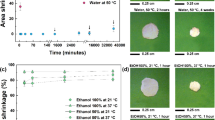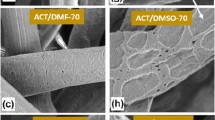Abstract
Control of the properties of electrospun polycaprolactone can be achieved by adjusting the acetic acid:water ratio used to dissolve and electrospin the polymer. In this work, we studied the effect of using up to 15 wt% water in the solvent mixture. Solution conductivity and viscosity and fibre morphology vary dramatically with water content and solution age. Two days after initial solution preparation, electrospinning yields regular fibres for a water content of 0 wt% and 5 wt%, irregular fibres for a 10 wt% water content and irregular and fused fibres for a 15 wt% water content. Fibres with the highest crystallinity (60%) were obtained from solutions containing 5 wt% water while the highest elastic modulus (8.6 ± 1.4 MPa) and tensile stress (4.3 ± 0.3 MPa) pertain to fibres obtained from solutions containing 10 wt% water. Enzymatic fibre degradation is faster the higher the water content in the precursor solution. Adhesion ratio of human foetal fibroblasts was highest on scaffolds obtained from precursor solutions containing 0 wt% water. Cell population increases for all scaffolds and populations quickly become equivalent, with no statistically significant differences between them. Cells exhibit a more extended morphology on the 5 wt% scaffold and a more compact morphology on the 0 wt% scaffold. In summary, a small water content in the solvent allows a significant control over fibre diameter, scaffold properties and the production of scaffolds that support cell adhesion and proliferation. This strategy can be used in soft tissue engineering to influence cell behaviour and the degradation rate of the scaffolds.






Similar content being viewed by others
References
Ramakrishna S, Fujihara K, Teo W-E, Lim T-C, Ma Z (2005) An introduction to electrospinning and nanofibers. World Scientific. https://doi.org/10.1142/5894
Szentivanyi AL, Zernetsch H, Menzel H, Glasmacher B (2011) A review of developments in electrospinning technology: new opportunities for the design of artificial tissue structures. Int J Artif Organs 34:986–997. https://doi.org/10.5301/ijao.5000062
Di Cio S, Gautrot JE (2016) Cell sensing of physical properties at the nanoscale: mechanisms and control of cell adhesion and phenotype. Acta Biomater 30:26–48. https://doi.org/10.1016/j.actbio.2015.11.027
Croisier F, Duwez A-S, Jérôme C, Léonard AF, van der Werf KO, Dijkstra PJ, Bennink ML (2012) Mechanical testing of electrospun PCL fibers. Acta Biomater 8:218–224. https://doi.org/10.1016/j.actbio.2011.08.015
Chen L, Yan C, Zheng Z (2017) Functional polymer surfaces for controlling cell behaviors. Mater Today 21:38–59. https://doi.org/10.1016/j.mattod.2017.07.002
Kim GH (2008) Electrospun PCL nanofibers with anisotropic mechanical properties as a biomedical scaffold. Biomed Mater 3:025010. https://doi.org/10.1088/1748-6041/3/2/025010
Gomes SR, Rodrigues G, Martins GG, Roberto M a, Mafra M, Henriques CMR, Silva JC (2015) In vitro and in vivo evaluation of electrospun nanofibers of PCL, chitosan and gelatin: A comparative study. Mater Sci Eng C 46:348–358. https://doi.org/10.1016/j.msec.2014.10.051
Cipitria A, Skelton A, Dargaville TR, Dalton PD, Hutmacher DW (2011) Design, fabrication and characterization of PCL electrospun scaffolds—a review. J Mater Chem 21:9419. https://doi.org/10.1039/c0jm04502k
Bhaskaran A, Prasad T, Kumary TV, Anil Kumar PR (2018) Simple and efficient approach for improved cytocompatibility and faster degradation of electrospun polycaprolactone fibers. Polym Bull 76:1333–1347. https://doi.org/10.1007/s00289-018-2442-7
Thakare VG, Joshi PA, Godse RR, Bhatkar VB, Wadegaokar PA, Omanwar SK (2017) Fabrication of polycaprolactone/zirconia nanofiber scaffolds using electrospinning technique. J Polym Res 24:232. https://doi.org/10.1007/s10965-017-1388-z
Kumar AP (2017) Self Organized Skin Equivalent by Epithelial and Fibroblast Cells on Polycaprolactone Electrospun Mat with Porous Fibers. Adv Tissue Eng Regen Med Open Access 3:1–6. https://doi.org/10.15406/atroa.2017.03.00056
Jahangiri M, Kalajahi AE, Rezaei M, Bagheri M (2019) Shape memory hydroxypropyl cellulose-g-poly (ε-caprolactone) networks with controlled drug release capabilities. J Polym Res 26:136. https://doi.org/10.1007/s10965-019-1798-1
Xie F, Zhang T, Bryant P, Kurusingal V, Colwell JM, Laycock B (2019) Degradation and stabilization of polyurethane elastomers. Prog Polym Sci 90:211–268. https://doi.org/10.1016/j.progpolymsci.2018.12.003
Olgun U, Tunç K, Hoş A (2019) Preparation and antibacterial properties of nano biocomposite Poly(ε-caprolactone)-SiO 2 films with nanosilver. J Polym Res 26. https://doi.org/10.1007/s10965-018-1686-0
Li WJ, Tuli R, Huang X, Laquerriere P, Tuan RS (2005) Multilineage differentiation of human mesenchymal stem cells in a three-dimensional nanofibrous scaffold. Biomaterials. 26:5158–5166. https://doi.org/10.1016/j.biomaterials.2005.01.002
Wise JK, Yarin AL, Megaridis CM, Cho M (2009) Chondrogenic differentiation of human mesenchymal stem cells on oriented nanofibrous scaffolds: engineering the superficial zone of articular cartilage. Tissue Eng Part A 15:913–921. https://doi.org/10.1089/ten.tea.2008.0109
Pitt CG, Chasalow FI, Hibionada YM, Klimas DM, Park T, Carolina N (1981) Aliphatic Polyesters . I . The Degradation of Poly ( e- caprolactone ) In Vivo. J Appl Polym Sci 26:3779–3787. https://doi.org/10.1002/app.1981.070261124
Woodward SC, Brewer PS, Moatamed F, Schindler A, Pitt CG (1985) The intracellular degradation of poly(epsilon-caprolactone). J Biomed Mater Res 19:437–444. https://doi.org/10.1002/jbm.820190408
Henriques C, Vidinha R, Botequim D, Borges JP, Silva JAMC (2009) A Systematic Study of Solution and Processing Parameters on Nanofiber Morphology Using a New Electrospinning Apparatus. J Nanosci Nanotechnol 9:3535–3545. https://doi.org/10.1166/jnn.2009.NS27
Guarino V, Cirillo V, Taddei P, Alvarez-Perez MA, Ambrosio L (2011) Tuning size scale and crystallinity of PCL electrospun fibres via solvent permittivity to address hMSC response. Macromol Biosci 11:1694–1705. https://doi.org/10.1002/mabi.201100204
Qin X, Wu D (2012) Effect of different solvents on poly(caprolactone) (PCL) electrospun nonwoven membranes. J Therm Anal Calorim 107:1007–1013. https://doi.org/10.1007/s10973-011-1640-4
Van Der Schueren L, De Schoenmaker B, Kalaoglu ÖI, De Clerck K (2011) An alternative solvent system for the steady state electrospinning of polycaprolactone. Eur Polym J 47:1256–1263. https://doi.org/10.1016/j.eurpolymj.2011.02.025
Ferreira JL, Gomes S, Henriques C, Borges JP, Silva JC (2014) Electrospinning polycaprolactone dissolved in glacial acetic acid: Fiber production, nonwoven characterization, and in vitro evaluation. J Appl Polym Sci 131:41068. https://doi.org/10.1002/app.41068
Li W, Shi L, Zhang X, Liu K, Ullah I, Cheng P (2018) Electrospinning of polycaprolactone nanofibers using H2O as benign additive in polycaprolactone/glacial acetic acid solution. J Appl Polym Sci 135:1–9. https://doi.org/10.1002/app.45578
Semnani D, Naghashzargar E, Hadjianfar M, Dehghan Manshadi F, Mohammadi S, Karbasi S, Effaty F (2017) Evaluation of PCL/chitosan electrospun nanofibers for liver tissue engineering. Int J Polym Mater Polym Biomater 66:149–157. https://doi.org/10.1080/00914037.2016.1190931
Kaur S, Rana D, Matsuura T, Sundarrajan S, Ramakrishna S (2012) Preparation and characterization of surface modified electrospun membranes for higher filtration flux. J Memb Sci 390–391:235–242. https://doi.org/10.1016/j.memsci.2011.11.045
Engler AJ, Sen S, Sweeney HL, Discher DE (2006) Matrix elasticity directs stem cell lineage specification. Cell. 126:677–689. https://doi.org/10.1016/j.cell.2006.06.044
Bauer AJP, Wu Y, Liu J, Li B (2015) Visualizing the inner architecture of poly(ϵ-caprolactone)-based biomaterials and its impact on performance optimization. Macromol Biosci 15:1554–1562. https://doi.org/10.1002/mabi.201500175
Wang Y, Rodriguez-Perez M a, Reis RL, Mano JF (2005) Thermal and thermomechanical behaviour of polycaprolactone and starch/polycaprolactone blends for biomedical applications. Macromol Mater Eng 290:792–801. https://doi.org/10.1002/mame.200500003
Schneider CA, Rasband WS, Eliceiri KW (2012) NIH image to ImageJ: 25 years of image analysis. Nat Methods 9:671–675. https://doi.org/10.1038/nmeth.2089
Álvarez E, Vázquez G, Sánchez-Vilas M, Sanjurjo B, Navaza JM (1997) Surface tension of organic acids + water binary mixtures from 20 °C to 50 °C. J Chem Eng Data 42:957–960. https://doi.org/10.1021/je970025m
Shin YM, Hohman MM, Brenner MP, Rutledge GC (2001) Experimental characterization of electrospinning: the electrically forced jet and instabilities. Polymer (Guildf). 42:09955–09967. https://doi.org/10.1016/S0032-3861(01)00540-7
Fukushima K, Feijoo JL, Yang MC (2012) Abiotic degradation of poly(DL-lactide), poly(ε-caprolactone) and their blends. Polym Degrad Stab 97:2347–2355. https://doi.org/10.1016/j.polymdegradstab.2012.07.030
Gholipour Kanani A, Bahrami SH (2011) Effect of changing solvents on poly(-Caprolactone) Nanofibrous webs morphology. J Nanomater 2011:1–10. https://doi.org/10.1155/2011/724153
Sajeev US, Anand KA, Menon D, Nair S (2008) Control of nanostructures in PVA, PVA/chitosan blends and PCL through electrospinning. Bull Mater Sci 31:343–351. https://doi.org/10.1007/s12034-008-0054-9
Lowery JL, Datta N, Rutledge GC (2010) Effect of fiber diameter, pore size and seeding method on growth of human dermal fibroblasts in electrospun poly(ɛ-caprolactone) fibrous mats. Biomaterials. 31:491–504. https://doi.org/10.1016/j.biomaterials.2009.09.072
Hsu C, Shivkumar S (2004) Nano-sized beads and porous fiber constructs of poly ( ε -caprolactone ) produced by electrospinning. J Mater Sci 9:3003–3013
Wong S-C, Baji A, Leng S (2008) Effect of fiber diameter on tensile properties of electrospun poly(ɛ-caprolactone). Polymer (Guildf) 49:4713–4722. https://doi.org/10.1016/j.polymer.2008.08.022
Johnson J, Niehaus A, Nichols S, Lee D, Koepsel J, Anderson D, Lannutti J (2009) Electrospun PCL in vitro: a microstructural basis for mechanical property changes. J Biomater Sci Polym Ed 20:467–481. https://doi.org/10.1163/156856209X416485
Balguid A, Mol A, van Marion MH, Bank R a, Bouten CVC, Baaijens FPT (2009) Tailoring Fiber Diameter in Electrospun Poly(ɛ-Caprolactone) Scaffolds for Optimal Cellular Infiltration in Cardiovascular Tissue Engineering. Tissue Eng A 15:437–444. https://doi.org/10.1089/ten.tea.2007.0294
Tan EPS, Ng SY, Lim CT (2005) Tensile testing of a single ultrafine polymeric fiber. Biomaterials. 26:1453–1456. https://doi.org/10.1016/j.biomaterials.2004.05.021
Sun L, Han RPS, Wang J, Lim CT (2008) Modeling the size-dependent elastic properties of polymeric nanofibers. Nanotechnology. 19:455706. https://doi.org/10.1088/0957-4484/19/45/455706
Yuan B, Wang J, Han RPS (2015) Capturing tensile size-dependency in polymer nanofiber elasticity. J Mech Behav Biomed Mater 42:26–31. https://doi.org/10.1016/j.jmbbm.2014.11.003
Lim CT, Tan EPS, Ng SY (2008) Effects of crystalline morphology on the tensile properties of electrospun polymer nanofibers. Appl Phys Lett 92:141908. https://doi.org/10.1063/1.2857478
Silver FH, Freeman JW, DeVore D (2001) Viscoelastic properties of human skin and processed dermis. Skin Res Technol 7:18–23. https://doi.org/10.1034/j.1600-0846.2001.007001018.x
Wu C, Jim TF, Gan Z, Zhao Y, Wang S (2000) A heterogeneous catalytic kinetics for enzymatic biodegradation of poly(ϵ-caprolactone) nanoparticles in aqueous solution. Polymer (Guildf). 41:3593–3597. https://doi.org/10.1016/S0032-3861(99)00586-8
Vieira T, Silva JC, Borges JP, Henriques C (2018) Synthesis, electrospinning and in vitro test of a new biodegradable gelatin-based poly(ester urethane urea) for soft tissue engineering. Eur Polym J 103:271–281. https://doi.org/10.1016/j.eurpolymj.2018.04.005
Martins AM, Pham QP, Malafaya PB, Sousa R a, Gomes ME, Raphael RM, Kasper FK, Reis RL, Mikos AG (2009) The role of lipase and alpha-amylase in the degradation of starch/poly(epsilon-caprolactone) fiber meshes and the osteogenic differentiation of cultured marrow stromal cells. Tissue Eng A 15:295–305. https://doi.org/10.1089/ten.tea.2008.0025
Venugopal JR, Zhang Y, Ramakrishna S (2006) In vitro culture of human dermal fibroblasts on electrospun Polycaprolactone collagen Nanofibrous membrane. Artif Organs 30:440–446. https://doi.org/10.1111/j.1525-1594.2006.00239.x
Woo KM, Chen VJ, Ma PX (2003) Nano-fibrous scaffolding architecture selectively enhances protein adsorption contributing to cell attachment. J Biomed Mater Res A 67:531–537. https://doi.org/10.1002/jbm.a.10098
Chen F, Lee CN, Teoh SH (2007) Nanofibrous modification on ultra-thin poly(e-caprolactone) membrane via electrospinning. Mater Sci Eng C 27:325–332. https://doi.org/10.1016/j.msec.2006.05.004
Washburn NR, Yamada KM, Simon CG, Kennedy SB, Amis EJ (2004) High-throughput investigation of osteoblast response to polymer crystallinity: influence of nanometer-scale roughness on proliferation. Biomaterials. 25:1215–1224. https://doi.org/10.1016/j.biomaterials.2003.08.043
Acknowledgements
This work was partly funded by FEDER through the COMPETE 2020 Programme and by National funds through FCT – Portuguese Foundation for Science and Technology – under the project UID/CTM/50025/2013.
Author information
Authors and Affiliations
Corresponding author
Additional information
Publisher’s note
Springer Nature remains neutral with regard to jurisdictional claims in published maps and institutional affiliations.
Rights and permissions
About this article
Cite this article
Gomes, S., Querido, D., Ferreira, J.L. et al. Using water to control electrospun Polycaprolactone fibre morphology for soft tissue engineering. J Polym Res 26, 222 (2019). https://doi.org/10.1007/s10965-019-1890-6
Received:
Accepted:
Published:
DOI: https://doi.org/10.1007/s10965-019-1890-6




